A SHROUDED WIND TURBINE GENERATING HIGH OUTPUT ...
A SHROUDED WIND TURBINE GENERATING HIGH OUTPUT ...
A SHROUDED WIND TURBINE GENERATING HIGH OUTPUT ...
Create successful ePaper yourself
Turn your PDF publications into a flip-book with our unique Google optimized e-Paper software.
obtained under the same wind speed and the<br />
swept area of a wind turbine.<br />
First, we compare Aii type with Sii type in<br />
Fig.7. Both types have an almost same area<br />
ratio µ. The C w of Aii is higher than Sii. It means<br />
that the curved sectional shape is preferable to<br />
the straight one. Furthermore, it is noted that<br />
the Bii and Cii types show higher C w compared<br />
to Aii type. It means that if the boundary-layer<br />
flow along the inside wall of curved diffuser<br />
dose not show a large separation, Bii and Cii<br />
types, which have a larger area ratio µ<br />
compared to that of Aii, are suitable to a<br />
compact diffuser.<br />
Table2 Parameters of C-type wind-lens<br />
Fig.8 Power coefficients of wind-lens turbine<br />
with C-type wind-lens (h=0.1D)<br />
Fig.7 Power coefficients of various wind-lens<br />
turbines<br />
3.3. Output power of wind-lens turbine with<br />
the compact diffuser length<br />
From the experimetal result shown in Fig.7,<br />
we discuss further C-type diffuser as the<br />
compact collection-accelaration structure. For<br />
the next step, we investigated the length effect<br />
of the C-type diffuser on the output<br />
performance of wind-lens turbines. We<br />
prepared four kinds of C-type diffusers from C0<br />
to Ciii, as described in Table 2. Fig. 8 shows the<br />
result of output performance with the four<br />
C-type diffuser lengths. The brim height is 10%,<br />
i.e., h=0.1D. Fig.9 also shows the variation of<br />
C w,max with the diffuser length L t /D, here C w,max<br />
is the maximun value of C w in the output<br />
perforamance curves as is shown in Fig.8. As it<br />
is expected, the C w,max value becomes smaller,<br />
as the diffuser length L t /D becomes smaller.<br />
However, when the brim height is larger than<br />
10%, i.e., in case of h0.1D, the C w of a<br />
wind-lens turbine with C0-type diffuser shows<br />
almost twofold increase compared to a bare<br />
wind turbine and the one with Ciii-type diffuser<br />
shows 2.6 times increase. Thus, we can expect<br />
2-3 times increase in output perforamnce, even<br />
if we use a very compact brimmed diffuser as<br />
the wind-lens structure.<br />
W.T. only<br />
C0<br />
C<br />
C<br />
C<br />
Fig.9 Maximum power coefficient Cw max vs.<br />
C-type wind-lens length<br />
3.4. Field experiment<br />
As described before, one of the merits of<br />
wind-lens turbine is the brim-based yaw control.<br />
Namely, owing to the brim, the wind-lens<br />
turbine automatically turns to face the wind.<br />
However, for the comapct wind-lens structure, it<br />
is difficult to realize the wind-lens turbine as the<br />
upwind-type wind turbine. Therefore, we made<br />
a prototype compact wind-lens turbine as a<br />
downwind-type one.<br />
3.4.1. 1kW wind-lens turbine<br />
For 1kW downwind-type wind turbine, we<br />
selected the Cii-type diffuser (L t /D=0.22) as the<br />
Diffuser C C C C0<br />
Lt/D 0.371 0.221 0.137 0.100<br />
µ 1.555 1.294 1.193 1.138
















